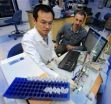(Press-News.org) Image of the Lafayette meteorite available from pressoffice@le.ac.uk
New research by the University of Leicester and The Open University into evidence of water on Mars, sufficiently warm enough to support life, has been published this week in the journal Earth and Planetary Science Letters.
The study determined that water temperatures on the Red Planet ranged from 50°C to 150°C. Microbes on Earth can live in similar waters, for example in the volcanic thermal springs at Yellowstone Park, the scientists behind the research point out.
The research is based on detailed scrutiny of Mars meteorites on Earth using powerful microscopes in the University of Leicester Department of Physics and Astronomy. This was followed-up by computer modeling work at The Open University.
Dr John Bridges, Reader in Planetary Science in the University of Leicester Space Research Centre and Lead Author, said: "Rovers on Mars – the Mars Exploration rovers Spirit and Opportunity, and the Mars Science Laboratory rover Curiosity – are studying rocks to find out about the geologic history of the Red Planet. Some of the most interesting questions are what we can find out about water, how much there was and what temperature it might have had.
"While the orbiters and rovers are studying the minerals on Mars, we also have meteorites from Mars here on Earth. They come in three different groups, the shergottites, the nakhlites and the chassignites. Of most interest for the question of water on Mars are the nakhlites, because this group of Martian meteorites contains small veins, which are filled with minerals formed by the action of water near the surface of Mars."
Dr. Bridges and his group studied those alteration minerals in great detail. Altogether eight nakhlite Martian meteorites are known, and all have small but significant differences between them and in their alteration minerals.
Lafayette is one of them; and the most complete succession of newly formed minerals can be found in its veins (see figure). Careful investigations of the minerals with an electron microscope and a transmission electron microscope have revealed that the first newly formed mineral to grow along the walls of the vein was iron carbonate. The carbonate would have been formed by CO2-rich water around 150°C. When the water cooled to 50°C, it would have formed the clay minerals, which were then followed by an amorphous phase that has the same composition as the clay.
Microbes use the reactions during mineral formation to gain energy and elements essential for their survival.
Dr Bridges added: "The mineralogical details we see tell us that there had been high carbon dioxide pressure in the veins to form the carbonates. Conditions then changed to less carbon dioxide in the fluid and clay minerals formed. We have a good understanding of the conditions minerals form in but to get to the details, chemical models are needed."
Dr Susanne Schwenzer, Postdoctoral Research Associate in the Department of Physical Sciences at The Open University who previously studied Martian meteorite compositions, said: "Until John's study was finished, I used the findings from orbiters around Mars, and modelled each of the new minerals individually. Those orbiters have found clays on the surface of Mars, but the spatial resolution is very different from the detailed study achieved in the nakhlites. Before we had the detailed study of the nakhlite meteorites, we did not know that carbonates are forming first, followed by the clays. Therefore I was very excited to see the details of the new mineralogical study."
By combining data from both universities, researchers were able to predict water conditions on Mars. Initially, the water was around 150°C and contained a lot of CO2, forming the carbonates, then cooled to about 50°C, thus forming the clays.
"The driving force heating the water might have been an impact into the Martian surface." Dr. Bridges explains. "And you only have to look at a map of Mars to see how numerous those are on the Martian surface," Dr. Schwenzer adds.
###
1. Bridges J.C. and Schwenzer S.P. The nakhlite hydrothermal brine on Mars. Earth and Planetary Science Letters 359 (2012) 117.
Meteorites reveal warm water existed on Mars
Hydrothermal fractures around Martian impact craters may have been a habitable environment for microbial life
2012-11-15
ELSE PRESS RELEASES FROM THIS DATE:
Cash cuts increase smoking death risk for world's poor, study says
2012-11-15
Proposed funding cuts within the international body responsible for tobacco control will leave the world's poorest countries more vulnerable to smoking-related diseases, a study suggests.
As many as 80 countries from the developing world, such as Paraguay, Rwanda, and Kyrgyzstan, could effectively be excluded from the forum tasked with reducing global tobacco use should the cuts go ahead.
The World Health Organisation's Framework Convention on Tobacco Control (FCTC) is considering cutting its funding for delegates from poorer countries to attend meetings.
Parties ...
Thermogenerator from the printer
2012-11-15
The computer activates an alarm: the machine's motor is threatening to overheat. The thermosensor attached directly to the motor housing reports the threat. The information is transmitted to the maintenance service which ensures that the cause is identified. Sensors can be used in factories, car manufacturers and other areas in everyday life. They measure temperature, humidity and wear and tear. Data is transmitted to the computer via wireless communication and read out. This enables the provision of information on the condition of parts – for instance, whether maintenance ...
GW Research chosen as 'paper of the week' for blood coagulation discovery
2012-11-15
WASHINGTON (Nov. 15, 2012) – Researchers at the George Washington University School of Medicine and Health Sciences (SMHS) will be featured as a top paper in next week's issue of the Journal of Biological Chemistry. Research by Rakesh Kumar, Ph.D., Catharine Birch McCormick Endowed Chair of the Department of Biochemistry and Molecular Biology and professor of biochemistry and molecular biology, and Beatriz Sánchez-Solana, postdoctoral fellow at the department of biochemistry and molecular medicine, both at SMHS, has been selected as the journal's "Paper of the Week". The ...
President's Bioethics Commission posts Study Guide
2012-11-15
Washington, D.C. – The Presidential Commission for the Study of Bioethical Issues today released an ethics study guide based on the Commission's investigation into the U.S. Public Health Service (PHS) experiments conducted in Guatemala in the 1940s. A Study Guide to "Ethically Impossible" STD Research in Guatemala from 1946 to 1948 is designed for use by higher education and other interested members of the public. It is free and available for immediate use in classrooms and elsewhere at www.bioethics.gov.
"As the world is now aware, the PHS research involved intentionally ...
ACA: More than a million women could gain access to potentially life saving tests for cancer
2012-11-15
WASHINGTON—A study by researchers at the George Washington University School of Public Health and Health Services (SPHHS) indicates that full implementation of the Affordable Care Act would expand health insurance coverage for more low-income women, enabling more than a million women to obtain potentially life-saving screening for breast and cervical cancer. The study, "Health Care Reform and Women's Insurance Coverage for Breast and Cervical Cancer Screening," was published in a recent issue of the journal Preventing Chronic Disease.
In the past, many low income women ...
Protein tug of war points toward better therapies for cardiovascular disease
2012-11-15
AUGUSTA, Ga. – Two proteins are in a tug of war that determines how much the body makes of superoxide, a highly reactive and potentially destructive product of oxygen that's dramatically elevated in cardiovascular disease, researchers report.
Their finding indicates an antiulcer drug just may help the body reduce excessive levels.
Hsp90 and Hsp70 are both heat shock proteins but appear to have opposite effects on reactive oxygen species production, said Dr. David J.R. Fulton, Interim Director of the Vascular Biology Center at the Medical College of Georgia at Georgia ...
Researchers uncover some good news for BC's troubled salmon populations
2012-11-15
Researchers uncover some good news for BC's troubled salmon populations
A University of Alberta led research team has some positive news for British Columbia's pink salmon populations, and the salmon farming industry that has struggled to protect both captive and wild salmon from sea lice infestations.
There has long been concern that concentrations of sea lice in BC's fish farming pens spread to wild fish stock in surrounding waters.
The researchers discovered that by changing the timing of sea lice treatments, one salmon farming region not only improved the health ...
Researchers use GPS tracking to monitor crab behavior
2012-11-15
This press release is available in German.
Researchers from Jena and Greifswald used GPS satellites for a long-term behavioral monitoring of land crab migration on Christmas Island. In cooperation with colleagues from the Zoological Institute at the University of Greifswald, scientists from the Max Planck Institute for Chemical Ecology in Jena, Germany, used a GPS-based telemetric system to analyze movements of freely roaming robber crabs, which is the first large-scale study of any arthropod using GPS technology to monitor behavior.
This analysis focussed on the ...
Born-again star foreshadows fate of solar system
2012-11-15
Astronomers have found evidence for a dying Sun-like star coming briefly back to life after casting its gassy shells out into space, mimicking the possible fate our own Solar System faces in a few billion years.
This new picture of the planetary nebula Abell 30, located 5500 light-years from Earth, is a composite of visible images from the NASA/ESA Hubble Space Telescope and X-ray data from ESA's XMM-Newton and NASA's Chandra space telescopes.
'Planetary nebula' is the name given to the often-concentric shells of stellar material cast into space by dying stars. To astronomers ...
X-rays from a reborn planetary nebula
2012-11-15
These images of the planetary nebula Abell 30, (a.k.a. A30), show one of the clearest views ever obtained of a special phase of evolution for these objects. The inset image on the right is a close-up view of A30 showing X-ray data from NASA's Chandra X-ray Observatory in purple and Hubble Space Telescope (HST) data showing optical emission from oxygen ions in orange. On the left is a larger view showing optical and X-ray data from the Kitt Peak National Observatory and ESA's XMM-Newton, respectively. In this image the optical data show emission from oxygen (orange) and ...
LAST 30 PRESS RELEASES:
University of Oklahoma researcher awarded funding to pursue AI-powered material design
Exploring how the visual system recovers following injury
Support for parents with infants at pediatric check-ups leads to better reading and math skills in elementary school
Kids’ behavioral health is a growing share of family health costs
Day & night: Cancer disrupts the brain’s natural rhythm
COVID-19 vaccination significantly reduces risk to pregnant women and baby
The role of vaccination in maternal and perinatal outcomes associated with COVID-19 in pregnancy
Mayo Clinic smartwatch system helps parents shorten and defuse children's severe tantrums early
Behavioral health spending spikes to 40% of all children’s health expenditures, nearly doubling in a decade
Digital cognitive behavioral treatment for generalized anxiety disorder
Expenditures for pediatric behavioral health care over time and estimated family financial burden
Air conditioning in nursing homes and mortality during extreme heat
The Alps to lose a record number of glaciers in the next decade
What makes a good proton conductor?
New science reporting guide published for journalists in Bulgaria
New international study reveals major survival gaps among children with cancer
New science reporting guide published for journalists in Turkey
Scientists develop a smarter mRNA therapy that knows which cells to target
Neuroanatomy-informed brain–machine hybrid intelligence for robust acoustic target detection
Eight SwRI hydrogen projects funded by ENERGYWERX
The Lundquist Institute and its start-up company Vitalex Biosciences Announces Strategic Advancement of Second-Generation fungal Vaccine VXV-01 through Phase 1 Trials under $40 Million Competitive Con
Fine particles in pollution are associated with early signs of autoimmune disease
Review article | Towards a Global Ground-Based Earth Observatory (GGBEO): Leveraging existing systems and networks
Penn and UMich create world’s smallest programmable, autonomous robots
Cleveland researchers launch first major study to address ‘hidden performance killer’ in athletes
To connect across politics, try saying what you oppose
Modulating key interaction prevents virus from entering cells
Project explores barriers to NHS career progression facing international medical graduates
Jeonbuk National University researchers explore the impact of different seasonings on the flavor perception of Doenjang soup
Two Keck Medicine of USC Hospitals named Leapfrog Top Teaching Hospitals
[Press-News.org] Meteorites reveal warm water existed on MarsHydrothermal fractures around Martian impact craters may have been a habitable environment for microbial life



